The itsy bitsy spider knows a thing or two about spinning webs. In fact, spiders are capable of weaving a variety of webs. Some will help them find dinner while others add a layer of protection to their homes. Spiders choose the web design that will benefit them the most. Check out how to identify common spider webs.

Very unusual and interesting spider web pattern.
Typical patterns for Paramatachia spiders. Other spiders in the same family (Desidae) make similar webs, like Badumna and Matachia. All can be found in Australia/NZ; the picture was supposedly taken in Tasmania.
SPIRAL ORB WEB

Spiral orb webs are what most people associate with spider webs. They are the large, circular webs that have a strong resemblance to wheels. They are easily recognizable by their spoke-like segments that meet in the middle of the web.
Spiders who weave these webs typically belong to the Araneidae family. These spiders like to keep their webs outside in forests and gardens.
Spiders will either wait on the web or hide nearby for their prey to land. If you aren’t quick, you’ll miss these webs. Orb Weavers typically take their webs down and rebuild it every night.
FUNNEL WEB

The funnel web is definitely for the sneaky spider. These webs are flat, horizontal webs with a funnel tube that leads to the spider’s burrow. Spiders hide in their homes and wait for their dinner to enter. They can then surprise attack them.
These webs are also perfect for a quick escape because of their back entrance. Spiders can easily slip out the back if they find themselves in danger. Webs are tucked in between plants and rocks.
Spiders of the Agelenidae family, like hobo spiders, are known for weaving funnel webs.

COBWEB
Cobwebs are a sticky mess. Unlike other webs, the design of cobwebs is irregular. The webs are jumbled which explains why they are sometimes called tangled webs.
If you spot a web in your house, there’s a good chance it’s a cobweb. Spiders weave these webs in corners and near ceilings, making sure that the web is anchored to something.
The Theridiidae family has mastered the art of cobweb creation. These spiders, including the black widow, rely on the sticky web for catching their next meal.
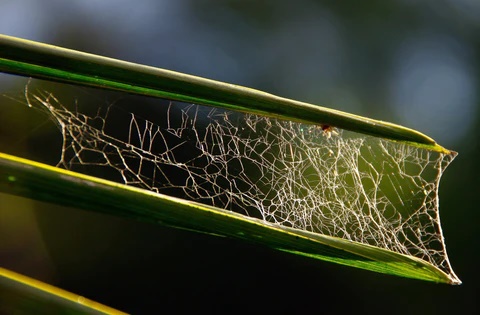
MESH WEB
Mesh webs could be considered the sister of cobwebs. While cobwebs are found inside our homes, mesh webs are found outside. Spiders weave these webs under leaves and rocks, among vegetation, and in fields.
Mesh-weaving spiders like to keep things low key. Their webs can be found on the ground or close to it. Though mesh webs are less chaotic in design than cobwebs, they still are a messy web.
Spiders in the Dictynidae family enjoy spinning mesh webs.

TRIANGLE WEB
The best way to visualize the triangle web is a slice of pizza. Spokes and spirals connect to three silky strands, which form a triangle.
These webs break the rules and aren’t sticky. They’re actually covered in tiny fibers that give the web a fuzzy texture. These fibers help the spiders to smother their prey.
One spider, the triangle weaver spider, takes this design and turns it into a slingshot. The triangle weaver tightly pulls a line of silk before releasing it. This results in the spider and the web launching forward. By doing this multiple times, the other silk strands fall and trap the spider’s prey.

SHEET WEB
Sheet webs are composed of thick layers of silk. They stretch across blades of grass and branches. Sheet-weaving spiders plant a few sneaky strands of silk above the web. When a bug flies into one of the strands, they will be knocked down into the web.
Sheet-weaving spiders will hide underneath the web and wait for their chance to strike. The Linyphiidae family is known to weave sheet webs. Though the webs can be flat, they also can have a domed or bowl-like appearance.
Spiders would definitely win the award for most crafty. Their unique web designs aren’t just cool to look at, they’re also practical. Without their webs, spiders wouldn’t enjoy nearly as many tasty meals. Which of these webs have you stumbled across? Let us know in the comments below!

A dew-covered spider web in autumn. Image courtesy of Pixabay (CC0).

A spider web frozen solid in winter. Image courtesy of pxhere (CC0).

Classic orb webs look like a bicycle wheel © AMAM1990/Shutterstock.com
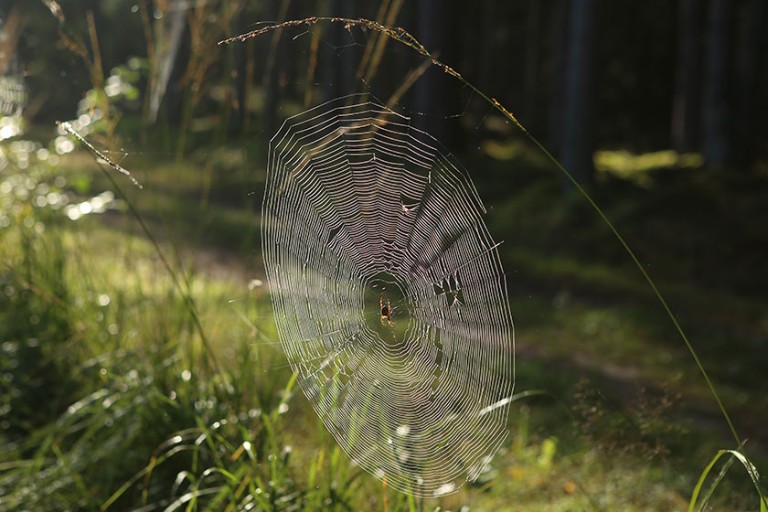
The webs of garden orb-weavers tend to be almost vertical and stretched across undisturbed spaces that are busy with insects such as flies, wasps and beetles © Giedre Vaitekune/Shutterstock.com
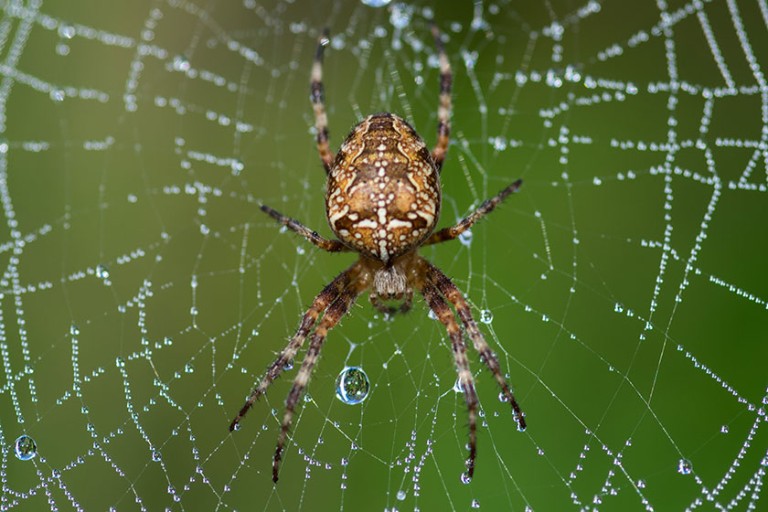
Close-up of the garden orb-weaver, Araneus diadematus. The abdomen of this spider is usually well-marked with a pattern of whitish spots that form a cross. Females can grow to 1.5cm long. Image courtesy of Pixabay (CC0).

A new web takes about two hours to build. Step one is to drift a silk line across a gap on the breeze. After strengthening this supporting strand with extra threads, the spider adds the radial and spiral threads.
To finish up the web, the spider removes the central knot of threads and replaces it with a lattice.
Missing sector orb-web
Web of Zygiella x-notata, with the typical missing sector top left © Anders Sandberg (CC BY 2.0), via Flickr
The spider waits in a head-down position at the centre of the web or lies hidden among nearby vegetation where it remains in contact by means of a signal thread. When an insect flies into the web the spider approaches the source of the vibrations, bites it and wraps it in silk, to feed on later.The missing sector orb weaver (Zygiella x-notata) constructs a very similar web, but one sector is left completely free of spirals. A strong signal thread passes through this sector to where the spider sits in its retreat. They’re commonly found on the outside of window frames.
Webs spun by Tetragnathidae spiders, the long-jawed orb weavers, follow a similar pattern to Araneus webs, but there is a hole in the centre. This is often where the spider takes up position, spanning the hole with its four hind legs. The webs can be in pretty much any orientation, not just vertical.
Theridiosoma gemmosum builds a web derived from the typical orb shape. These small webs have an open hub and resemble an inside-out umbrella. The species is rare, found on low-growing plants near water in southern Britain.

Wasp spider
Some orb-weaver spiders add decoration to their webs: an extra band of silk called the stabilimentum.
This is particularly striking in the case of the wasp spider (Argiope bruennichi). It incorporates a zig-zag of dense, white silk down the centre of its web. What this is for still isn’t known, but there are a few ideas.

The garden centre spider, Uloborus plumipes, on its cribellate silk web, which acts like Velcro and stops prey escaping © Jiri Prochazka/Shutterstock.comThe orb web of Uloborus plumipes is similar to that of Araneus diadematus but usually more horizontal – sometimes across the tops of plant pots – and the threads are fluffier.
The spider is an expert in camouflage, resembling dried vegetation when at rest.
Since the web often looks a bit scruffy, it gives the impression of an abandoned web with dead plant material stuck to it. Even the spider’s egg sac looks like a dead holly leaf.
Researchers studying Uloborus plumipes have shown that cribellate silk is extremely fine (just a few nanometres thick – much thinner than most other silk) and the spider electrostatically charges the threads by combing them with specialist hairs on its hind legs.
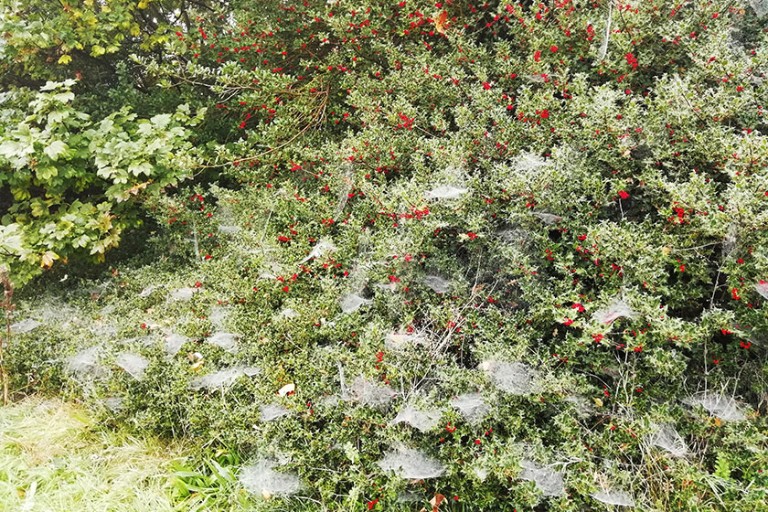
Dew revealed a multitude of sheet webs on this holly bush © James McNish

Sheet webs collect insects that fall onto them from above © Irelandimages/Shutterstock.com
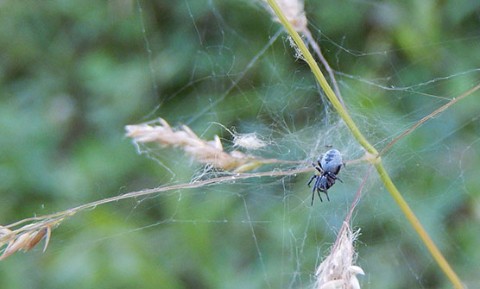
A Dictynidae spider on a web built over a few heads of grass © Luca Fornasari (CC BY-SA 4.0), via Wikimedia Commons

Pholcus phalangioides is a dainty looking spider © LFRabanedo/Shutterstock.com
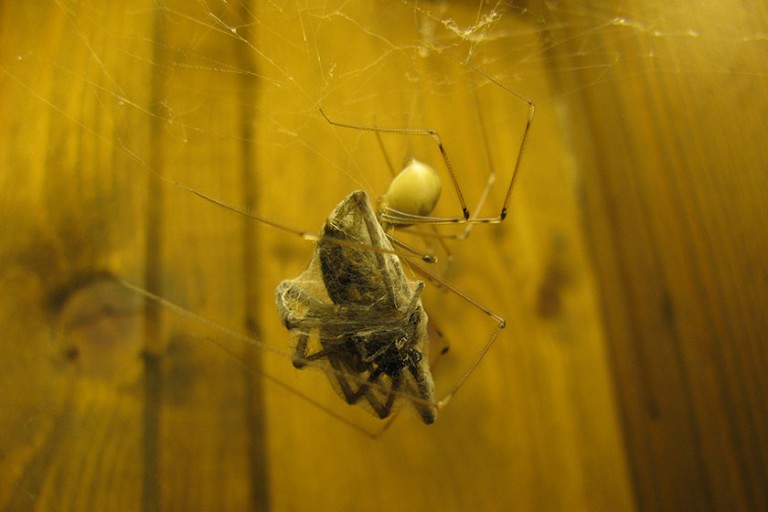
Despite its puny appearance, Pholcus phalangioides can take on large house spiders and win. Image courtesy of McZul (CC0), via Wikimedia Commons.

The trip wire threads are clearly visible on this radial web © crabchick (CC BY 2.0), via Flickr





